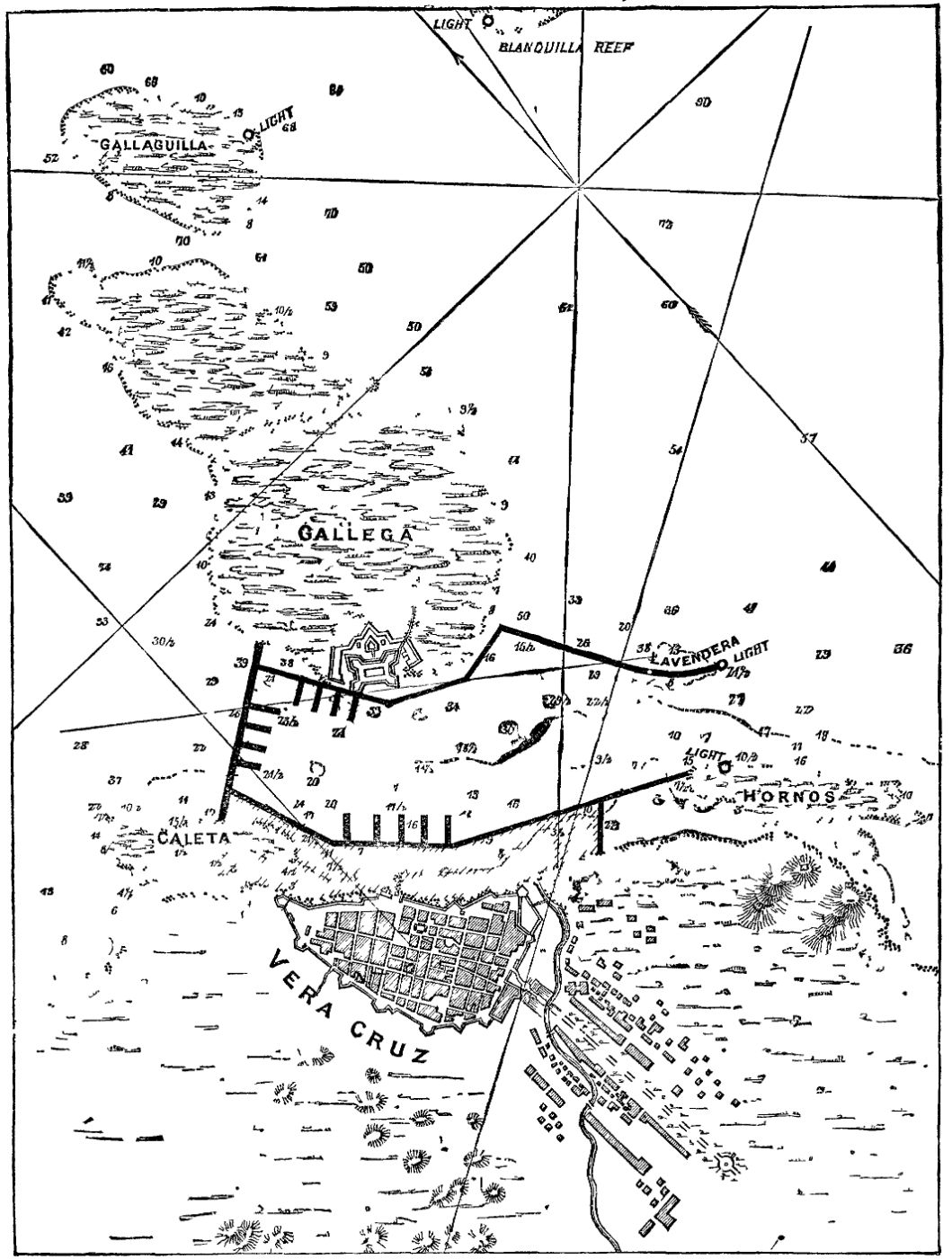Scientific American Supplement, No. 365, December 30, 1882 by Various, is part of the HackerNoon Books Series. You can jump to any chapter in this book here. THE NEW HARBOR OF VERA CRUZ.
THE NEW HARBOR OF VERA CRUZ.
Besides the enormous engineering work of rendering navigable one of the mouths of the Mississippi Delta, and the continuous labor of developing the more original and still bolder project for an Isthmian ship railway, Mr. James B. Eads has been engaged in the design of new and extensive harbor works at Vera Cruz, which, when completed, will secure for that city a commodious and secure port. The accompanying plan shows the natural features of the locality, as well as the new works. The harbor is formed by the coast line from the Punta de la Caleta to the Punta de Hornos, and by La Gallega reef. From the first named point a coral reef, nearly dry at low water, extends out about 300 yards into the gulf, and a similar one of about the same length runs out from the Punta de Hornos. Between these is a bay 2,000 meters wide, and at its northwest end lies the city of Vera Cruz. The bay is partly inclosed by an island or reef—La Gallega—which, on the harbor front, has a length of 1,200 meters. Beyond this, and to the southeast, is another small island—the Lavendera reef. Between the end of this reef and that projecting from the Punta de Hornos is 320 meters wide. As will be seen from the plan the natural harbor is exposed to the gale from the north and northwest, while the formation affords general protection from the northeast and southeast thanks to five large coral reefs. Not unfrequently, however, heavy seas sweep through the wide channels between these small islands interfering seriously with vessels lying alongside the present limited wharfage. Northeast, La Gallega and Gallaguilla reefs run northward from the harbor for 3,300 meters and these with the main coast line, form a bay exposed to the full fury of the winds from the north, and when northern winds prevail rough water is driven through the passage between La Gallega and Caleta reefs with great violence, and sets up a rapid and dangerous current into the harbor.

From the foregoing it will be seen that, while presenting some advantages, the natural harbor of Vera Cruz possesses many drawbacks and dangers which the design of Mr. Eads will completely remove. The leading features of the works about to be carried out are indicated on the plan. They comprise
-
The construction of a sea wall between La Gallega and the Lavendera reefs, with an extension over the latter.
-
The construction of a sea wall from Punta de la Caleta to La Gallega. This part of the work will be begun after the completion of the first wall to a height of at least 3 ft. above low water.
-
A dike connecting the northern ends of the first two dikes with each other, and stretching across the southern part of La Gallega, to prevent the seas which sometimes break over this reef from entering the harbor. The wall between La Gallega and Lavendera will not only cut off the rough water during northerly gales, but will also effectually prevent the deposition of sand in the harbor, because the through passage to the northwest will be stopped. Passages closed by sluice gates will be formed through this wall at about low water level, so that at any time the harbor may be flushed out and stagnation prevented.
-
After the construction of the inclosing walls the harbor will be dredged out and cleared of coral to a depth of 25ft. below low water.
-
Following these works of primary importance comes the construction of a wooden roadway from the Hornos reef to the northwestern dike. This roadway will form the south front of the harbor, and the excavated material will be deposited on the space between the roadway and the existing bottom, so as ultimately to make it a permanent work with a masonry retaining wall fronting the harbor. The land between the roadway and the city would also be reclaimed to the extent of more than 740,000 square yards.
-
The construction of wooden piers at right angles to the roadway, which would be extended to run around the harbor as trade required it, for ships to be alongside for loading and unloading. The construction of these short piers would be similar to those used in New York and other United States ports, and they might afterward be replaced by masonry if the increase in trade justified so large an expenditure.
-
The erection of a lighthouse, at or near the eastern end of the Lavendera sea wall of a second on the eastern side of La Gallaguilla reef, and of another on the west side of La Blanquilla reef. These houses will be furnished with distinctive signals to enable steamers running in before another to run with safety between La Gallaguilla and La Blanquilla as soon as the Lavendera light is seen between the other two.
The width of deep water at the entrance between the Lavendera and Hornos reefs will be 1,000 ft. The estimated cost of these extensive works is ten millions of dollars, a large sum for the Mexican Republic to expend in harbor improvements at one port but it will doubtless be found a profitable investment as it will tend greatly to promote trade, and so increase indefinitely the commerce of the port.
Mr. Eads' plan having been approved by the Mexican Government the work was formally commenced on the 14th of last August. Plans were also furnished by him at the request of the Government, for deepening the mouth of the Panuco River upon which is located the city of Tampico, the Gulf terminus of the Mexican central railway system.—Engineering.
About HackerNoon Book Series: We bring you the most important technical, scientific, and insightful public domain books.
This book is part of the public domain. Various (2006). Scientific American Supplement, No. 365, December 30, 1882. Urbana, Illinois: Project Gutenberg. Retrieved https://www.gutenberg.org/cache/epub/18763/pg18763-images.html
This eBook is for the use of anyone anywhere at no cost and with almost no restrictions whatsoever. You may copy it, give it away or re-use it under the terms of the Project Gutenberg License included with this eBook or online at www.gutenberg.org, located at https://www.gutenberg.org/policy/license.html.

